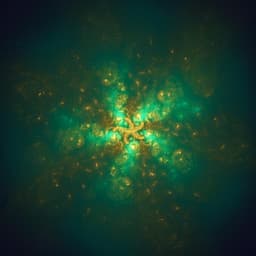
Physics
Polaritonic states trapped by topological defects
D. Smirnova, F. Komissarenko, et al.
This innovative research conducted by Daria Smirnova, Filipp Komissarenko, Anton Vakulenko, Svetlana Kiriushechkina, Ekaterina Smolina, Sriram Guddala, Monica Allen, Jeffery Allen, Andrea Alù, and Alexander B. Khanikaev introduces a novel mechanism to trap mid-IR structured phonon-polaritons using topological defects in a metasurface integrated with hexagonal boron nitride, paving the way for advances in light-matter wave control and thermal management.
Playback language: English
Introduction
The miniaturization of photonic technologies necessitates the integration of diverse materials to achieve novel functionalities in chip-scale devices. Topological photonic systems are a promising platform for coupling structured light with solid-state matter excitations, enabling robust 1D polaritonic transport. Symmetry engineering of electromagnetic modes in metamaterials offers an effective approach to tailor optical properties and produce novel responses. In topological photonics, spatial symmetries generate photonic pseudo-spin, creating structured light that can be trapped and guided along topological interfaces based on field helicity. More recently, crystalline symmetries have been used to generate higher-order topological phases and defects, enabling the trapping of radiation to zero-dimensional boundaries, forming nanoscale topological photonic cavities. While topological boundary modes have found applications in nonlinear optics, lasers, and light-matter interactions, the control of optical fields on polaritonic chips remains underutilized. Complete control would allow the design of selection rules for light-matter interactions. Previous work has shown some chiral light-matter interactions in topological systems with van der Waals materials for guided topological edge modes, but studies on higher-order and topological defect modes are lacking. This research addresses this gap by presenting a hybrid polaritonic cavity design based on a zero-dimensional (0D) topological defect in a planar metasurface capable of trapping point-like higher-order topological (HOT) polariton states. The study experimentally demonstrates the chiral structure of these states, stemming from their topological nature with spiral polarization texture and selective one-way coupling to topological interface modes.
Literature Review
The paper extensively reviews the existing literature on topological photonics, highlighting the use of symmetry engineering in metamaterials to tailor optical properties. It cites several works demonstrating the generation of photonic pseudo-spin and the trapping and guiding of light along topological interfaces. The review also covers the more recent advancements in higher-order topological phases and the creation of nanoscale topological photonic cavities using topological defects. The authors point to the successful applications of topological boundary modes across various frequency domains and spatial dimensions, including nonlinear optics, lasers, and light-matter interactions. However, they emphasize the lack of understanding and underutilization of optical field structures on nanoscale polaritonic chips, particularly concerning higher-order modes and topological defects. The review specifically notes the limited research on chiral light-matter interactions in higher-order topological defect modes involving van der Waals materials, framing the current study as a significant contribution to this area.
Methodology
The research employed a hybrid topological metasurface design consisting of a patterned silicon (Si) slab covered with a thin layer of hexagonal boron nitride (hBN). The photonic structure is composed of hexamers of triangular holes in a silicon slab, forming a deformed honeycomb (Kekulé) pattern. Topological defects were created by stitching three domains with the same deformation type, resulting in a point defect and line defects. The system's physics, including photon-phonon interactions and the formation of hybrid polariton states, was captured using an effective Dirac-like Hamiltonian. This Hamiltonian operates on a six-component wave function encompassing photonic and phononic degrees of freedom. The photonic sector represents a massive Dirac model with a gapped doubly degenerate spectrum, while the phononic sector represents two in-plane TO phonon modes in hBN. The model parameters were estimated by fitting to full-wave numerical simulations performed using a three-dimensional finite-element-method (FEM) solver (COMSOL Multiphysics). The effective Dirac-like model provided an analytical model in the continuum limit, enabling the analysis of both line defects and point defects. For line defects, periodic boundary conditions were imposed along the y-axis to analyze modes bound to the interface. For point defects, the solution was found assuming an eigenvector residing at one sublattice. The frequency of the 0D HOT mode and its spatial profile were obtained by solving the system of equations from the Hamiltonian with continuity conditions at the three rays. Experimentally, a hybrid metasurface was fabricated using electron beam lithography and anisotropic plasma etching. A 15 nm layer of hBN was transferred onto the metasurface. A custom-built mid-IR imaging setup, employing a thermal imaging camera and a quantum cascade laser, was used for characterization in real and Fourier space. This allowed for the construction of 3D Fourier maps by varying the laser frequency. Real-space imaging confirmed the presence of spatially localized trapped modes, while far-field imaging characterized radiation patterns and polarization textures. Stokes polarimetry was used to extract the full set of Stokes parameters and reconstruct the polarization structure. Finally, a trapezoid-shaped geometry was fabricated to demonstrate the compatibility of 0D modes with 1D boundary modes, and selective excitation of polaritonic HOT defect modes was experimentally verified.
Key Findings
The key findings of the research include the successful experimental demonstration of trapping mid-infrared phonon-polaritons in zero-dimensional (0D) higher-order topological (HOT) defects within a hybrid metasurface. The metasurface, consisting of a Kekulé-patterned silicon metasurface overlaid with a thin layer of hexagonal boron nitride (hBN), exhibited strong light-matter coupling, leading to the formation of hybrid polariton states. These HOT modes were experimentally confirmed through real-space imaging, revealing their spatial localization around the point defects. Furthermore, Fourier-space imaging and Stokes polarimetry revealed the chiral nature of the far-field radiation patterns and their spiral polarization textures. The observed three-lobe radiation pattern with a singularity at the normal direction was consistent with theoretical predictions derived from the effective Dirac model. The research also demonstrated the selective excitation of these HOT modes through spin-polarized edge waves propagating along heterogeneous topological interfaces. The unidirectional propagation of spin-up and spin-down modes towards corresponding corner junctions, depending on the circular polarization of the excitation source, was experimentally verified. This finding highlights the potential for controlling the dimensionality and propagation of polaritonic states within the same device. The experimental results, including band diagrams showing upper and lower polariton branches due to the strong coupling with hBN, and real-space imaging of both line and point defect modes, strongly support the theoretical model and the topological origin of the observed phenomena. The close agreement between numerical simulations and experimental results validates the proposed effective Dirac-like model and its ability to capture the essential physics of the system.
Discussion
The findings of this research address the need for advanced control over light-matter interactions at the nanoscale. The successful trapping of phonon-polaritons in 0D HOT defects and the demonstration of selective excitation through spin-polarized edge waves open up new possibilities for manipulating light and matter excitations in a controlled manner. The ability to confine light and phonons to nanoscale dimensions and control their propagation pathways has significant implications for various applications, including the development of ultrathin light sources, efficient thermal management devices, and novel sensors. The unique chiral properties of the trapped modes, evidenced by the spiral polarization texture and the singular radiation pattern, could find applications in quantum information processing and optical communication. The demonstrated compatibility between 0D and 1D topological states within the same platform allows for the creation of complex topological networks, opening up possibilities for more sophisticated device architectures. The work bridges the gap between previous studies on topological edge states and the emerging field of higher-order topological phases in photonics, providing a comprehensive framework for understanding and controlling light-matter interactions in these systems.
Conclusion
This research successfully demonstrated the trapping of mid-infrared phonon-polaritons in zero-dimensional higher-order topological defects within a hybrid metasurface. The experimental findings confirm the theoretical model, highlighting the chiral nature of the trapped modes and their selective excitation via spin-polarized edge waves. This work provides a significant advancement in topological polaritonics, paving the way for the development of novel nanoscale photonic devices. Future research directions include exploring the potential of this platform for quantum information processing, realizing more complex topological networks, and investigating the effects of strong light-matter coupling on topological phase transitions. Extending this work to other van der Waals materials and exploring different lattice geometries could further expand the functionalities of this platform.
Limitations
While the study provides a comprehensive investigation of the proposed system, some limitations exist. The fabrication process, involving electron beam lithography and hBN transfer, could be further optimized for improved yield and scalability. The current experiments were performed at a fixed temperature; future investigations should explore the temperature dependence of the polaritonic states. The theoretical model relies on several approximations, such as the effective Dirac-like Hamiltonian, which simplifies the underlying physics. A more comprehensive theoretical approach might be needed to capture the full complexity of the system. The experimental setup, while capable of precise measurements, was limited in its ability to fully characterize the dynamic properties of the polariton states.
Related Publications
Explore these studies to deepen your understanding of the subject.







